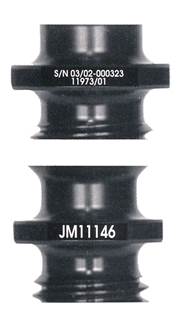When Should I Replace My Retention Knobs?
The retention knob is something that is often overlooked, yet it is the most critical connection between your machine and tooling. A question we often receive is ‘How long is a retention knob designed to last?’ A general rule of thumb is that a pull stud has a lifespan of about 3 years. This is for shops that run standard 5 day/week, 8 hour shifts. If the shop is running 24 hours a day, the retention knob is only good for one year.
Using a retention knob that has been marked with a part number, serial number, lot number, and date can help you track the life cycle of the pull stud. At JM Performance Products, we have been manufacturing retention knobs for over 20 years and we laser mark all of this information right on our retention knobs. In the event of a broken retention knob, this information can help you and the retention knob manufacturer determine what may have happened. Other signs to look for on a worn retention knob are wear marks from machine grippers or ball bearings. Also, once a retention knob becomes too fatigued the pull stud can develop cracks. When these signs are prevalent, it’s time to change your retention knob. If a pull stud breaks during engagement, this can damage the work piece along with the machine spindle. Examining your machine’s retention knobs can also help you determine other problems going on inside your machine. A retention knob can show if there are signs of a tool that has slipped in the spindle or if a drawbar needs to be rebuilt. With the average spindle repair costing $5,000 to $50,000, plus machine downtime, the retention knob is an item that needs to be evaluated in your facility.

Above: A JM retention knob laser marked with manufacturing info
